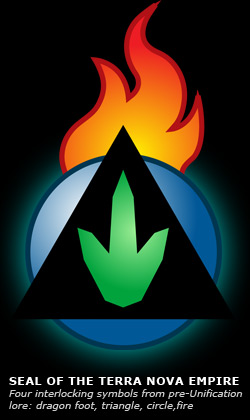 Not every empire can claim to be the first galactic civilization, the current leading superpower, or have a founding date that set the zero mark for the modern timeline. But Terra Nova can claim all of these.
Not every empire can claim to be the first galactic civilization, the current leading superpower, or have a founding date that set the zero mark for the modern timeline. But Terra Nova can claim all of these.
The Empire is based from its central and founding planet, Terra Nova, a world that is today populated by humans and dragons. But curious geological evidence suggests that neither race is indigenous to the planet and instead migrated there millennia ago. This fits with existing histories and legends from both groups: dragons tell a tale of gradual migration as they sought the spiritual center of dragonkind in Aesgar, and found it on Terra Nova; humans have sparse records that show Terrans under Taep Oceuna made landfall millennia ago and fought the dragons in a thousand-year cold war. The two groups eventually formed an alliance and learned to coexist.
Two other major ethnic groups – the Elurians and Terrellians – eventually allied with Terra Nova as well. Though both had reached the stars and perhaps even established meager civilizations, it is clear that neither was particularly strong. After the Elurians and Terrellians united with the Terrans under a single banner, the Terra Nova Empire was officially born. Their combined strength resulted in rapid expansion and the first true galactic civilization and superpower. In fact, Terra Nova Unification provided the modern dating system with its baseline; dates are measured in years
BU (Before Unification) or AU (After Unification).
But it should also be noted that the dragons of Terra Nova provide its true backbone and strength. Their wisdom and raw power have provided the guiding force of the Empire since its inception, and they themselves are either revered or feared by all.
Though the Terra Nova Empire is a glorious success story of ingenuity and perseverance, much of this is due to its beginning strategic position, which provided an enormous boost not available to potential rivals. The three main Terran groups were already spread to any number of star systems, giving established economic channels and resources. Unification of the three major races also provided the fledgling empire with a solid core of loyalty, despite ethnic differences. As such, it had a more solid base from which to expand, in contrast to pre-Confederacy Graedius and its allies. The other major potential rivals of the time were the Orian Empire and Soltari Prefecture. Both were too distant to ever be a threat to Terra Nova, and the closer Oriani would deal with outside incursions and the wealth of Graedius for some centuries, until their fall to the Nebulans.
While these early advantages of Terra Nova paved the way for its ascendance to supremacy in Aesgar, this is not to say that the Empire did not suffer its share of difficulties – nor were the enemies it did face easy prey.
A number of wars would be marked in the histories of the Terra Nova Empire, in which the valor of its armies and the generosity of its statesmen would both win renown. Even the Nebulans record these Terran victories as most worthy. The very rumor of Terra Nova’s coming would often open immediate diplomatic channels. Worlds on the farthest Fringe of the age would send envoys to establish good relations long in advance of their coming. Terra Nova’s virtues ensured that, while the army would see action, it would mainly be in defense of the Empire’s interests – not as an aggressive tool of repression.
More than once, however, Terra Nova’s influence and military were nearly put to more severe tests. The rising Nebulan civilization caused concern beginning the 1300s, as they slowly and methodically conquered the Orian Empire – a state long friendly with Terra Nova and its main outlet to the northern Fringe. The Orians’ destruction in 1358 at the hands of the Nebulans caused alarm in the Terran state. The concern of the time was not so much a fear of being conquered as a fear of the destruction a conflict would inflict. A reputation for fanaticism and savagery preceded the Nebulans, as did their tactical skill. The Nebulan Star Empire was the first large-scale, aggressively expansionist state in known Aesgar, and cut off Terran contact with the northern Fringe almost entirely, save through Graedius. Terra Nova kept close tabs on Nebulan conquests; some believe that Terra Nova fought proxy wars against them, and even used covert ops to sabotage them when possible. No such stories have been confirmed or denied.
No wars resulted, however, though the animosity between the two states remained. In the last five hundred years, no less than three incidents have resulted in nearly sparking a galactic war. The conquest of the Graedian Confederacy strained Terran patience as a flagrant act of aggression and nearly caused an economic depression. The Fringe War also saw a near-escalation, as some powerful political factions attempted to push Terra Nova to support the Graedian Confederacy’s fight for independence. Fortunately, such a rash decision was defeated and galactic war averted. The third incident was the Durson War, where some clashes took place between Terran and Nebulan “peacekeeping” forces. But the commanders of the three states involved manage to overcome differences and organize their efforts against the Dursoni, later resulting in the First League Conference on Mileos.
Terra Nova of the present remains the largest and strongest state known in Aesgar. Its economy is strong, its people highly intelligent, and its military vast. No state has had such unwavering success in its expansion and organization. For the long foreseeable future, Terra Nova looks to maintain its superiority.
![]()

